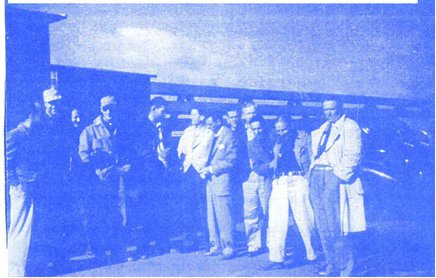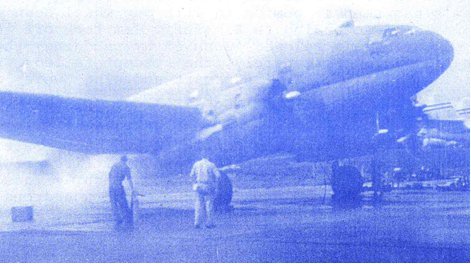By Michael Finegood
The recent death of Sam Lewis brings to an end the career of one of the distinguished members of Machal. The role that Sam played in the formation of the Israel Air Force has been well documented in Leonard Slater’s book “The Pledge.” He and Al Schwimmer had the foresight and daring to begin buying war surplus aircraft, organizing and training flight crews and collecting a staff of maintenance personnel.
Details of this particular group have not been recorded till now. I refer to the close-knit group of friends who unwittingly played a very important role in the Israel Air Force, though not officially. They called themselves the “Cobbers,” Australian slang for buddies. As employees of Consolidated Aircraft of San Diego, they had served as civilians in maintaining U.S. planes in Australia during World War II.
Several of them were employed by Schwimmer at his base in Burbank, CA. They worked night and day preparing the C-46s and Constellations for their flights out of the U.S. before the embargo deadline imposed by President Truman.

Burbank Airport 1948 – fifth from left – Fred Dahms, Mike Ondra, Stew, Bob Pucher, Andy Antilia, T. Taylor
They flew with the planes to Panama under the delusion that they were working for a new airline which would eventually be operating out of a base in Italy. Because of the desperate need for crews to fly the planes out of California, two of the mechanics who held private licenses flew as co-pilots from Mine’s Field (now LAX Los Angeles), Bob Dawn with Leo Singer to Panama and Glen (Bud) King with Bill Gerson to Mexico City. The last two became Machal’s first Air Force casualties when their heavily overloaded plane crashed in attempting a take-off from the airport there. To Templeton “T” Taylor, another one of the Cobbers, fell the unpleasant duty of bearing the sad tidings to Glen’s wife, who fainted in his arms when she heard the news.

Panama, circa June 1, 1948. Fred Dahms with fire extinguisher, Mike Ondra in cockpit of a C-46, one of “those old crates”
All the members of the group were gentiles who were unaware of the fact that this was an Israeli operation. Other members were Gardner Barker (Shorty), only slightly over five-feet tall but a giant of a man; Fred Dahms, who was later joined by his wife Evelyn who did yeoman duty under difficult conditions in the maintenance department at Ekron; Mike Ondra, of Czech descent, whose knowledge of the language served the group well while they were at the base at Zatec; William Postell, who served in the IAF for several years after the war, and whose young son spoke Hebrew like a sabra; and Al Pozzoli, of Italian descent, whose knowledge of the language proved very useful in Italy. Two others who might be called “honorary” Cobbers were Bob Pucher and Bob Lofte. Ernie Stehlik, another American of Czech descent, was an expert on the Constellation and was Schwimmer’s right-hand man from the beginning. His fluency in the Czech language was a great help during the operation in Zatec.
The importance of their service cannot be overestimated. Pucher offered his services when there was a call for a volunteer to go to the Israeli base at Ekron during “Operation Balak,” the supply flights to beleaguered Israel. Taylor was in charge of maintenance in Corsica, Dahms and Barker volunteered for the base in Yugoslavia while Dawn and Stehlik were based at Zatec. They were key elements in that vital operation which helped to stem the tide of the Arab invasion.

Mike Ondra and Fred Dahms in Zatec
But now to backtrack: When the base in Italy had to be abandoned due to the efforts of the C.I.A., all the mechanics were given the option of a return to the U.S. via commercial airlines, or the opportunity to continue with the planes to Czechoslovakia behind the “Iron Curtain.” Most of the men, who by now knew that this was an Israeli operation, decided to return home, but not the Cobbers. They had become as dedicated to the Israeli cause as their Jewish friends. Later, when forced to depart hastily from Zatec, they too joined the exodus. However, Bob Dawn and Ernie Stehlik remained behind to repair the sole Constellation which had made an emergency landing.
Shorty Barker and Fred Dahms, along with Geda Schochat, the sabra base commander, as well as three transient crewmen were left behind at the Yugoslav base; they had an adventurous trip that took several weeks until they arrived at Rijeka in northern Yugoslavia, where they joined the crew of the Pan Crescent that was bringing a load of refugees to Israel.
Working with the ship’s crew, this was their first contact with the displaced Jews of Europe. According to Dahms: “All passengers had to remain below deck until the ship was out of the Adriatic Sea and into the Mediterranean, then the crew opened up the hatches and the deck filled with youngsters, singing, dancing, enjoying, a beautiful bunch of young people.”
Back at Zatec, Dawn and Stehlik labored to repair the Constellation. It had landed on one wheel on a return flight from Israel flown by Marty Ribacoff. Sam Lewis had seen it coming in with one wheel down and alerted Ribacoff to the problem. According to Ribacoff, Sam took off in a BT-13 in a vain attempt to succor his beloved “Connie” (Constellation) by nudging the reluctant wheel down with his wing. Fortunately, the attempt failed, for it was virtually a suicide mission. The under-cart and wing were damaged and required considerable repairs before the plane could be flown back to the U.S.
In addition to the work on the Constellation, Bob Dawn cooperated with Sam Pomerance and David Panar in the selection of 50 Spitfire fighter planes which the Czechs agreed to sell to Israel for $23,000 each. These were the planes with which the British had equipped the Czech squadrons in England during the war. They returned home but now the Russians wanted them to convert to Soviet aircraft and so the planes were made available for sale.
When the first six were available and had been equipped with long range tanks by Pomerance, they were to be flown to Israel via Yugoslavia. Dawn flew in the C-54 guide plane as flight engineer to monitor fuel consumption on the flight from the Yugoslav base to Israel. Unfortunately, two of the aircraft ran short of fuel and had to abort the flight and land on the island of Rhodes, where the planes were impounded and the pilots detained for a short time. Dawn returned to Zatec and determined that the two pilots had distrusted the crude gauges which had been installed on the main tanks and had pumped gas into full tanks, which proceeded to flow out of the vents. The forward-facing vents in the external tanks had had sufficient air pressure to force the fuel into the main tanks. The other pilots, trusting the crude gauges, managed to reach Israel safely with the remaining planes. However, the Yugoslavs, embarrassed that the use of their base had been disclosed, ordered Geda and his group to depart immediately. Later they permitted the base to be used for the flights of additional Spits to Israel in Operation “Velvetta 2.” After their arrival in Israel, the Cobbers were stationed at Ekron where they played a key role in setting up the maintenance facilities. They later established the same facilities for El Al and Bedek, which became Israel Aircraft Industries.
Much of the above is covered in the unpublished manuscript of Evelyn Dahms. A copy, entitled “In the Arms of David,” has been presented to the IAF Historical Section archives, as have numerous historically important photos. Another copy has been given to the archives at the University of Florida.
Listed below are some of Bob Dawn‘s accomplishments. Similar lists could be compiled by the others of the group, as well as Jim McGunigal of Toronto, Don Roverts who was in charge of maintenance at Ekron, and Bob Lofte. Their stories will be dealt with at length in my forthcoming book.
Dawn’s list includes:
1. Procurement, preparation and delivery of C-46s from Burbank to Israel.
2. Maintenance of C-46s during the shipment of ME-109s and other armaments.
3. Preparation of three B-17s for their mission to Israel.
4. Servicing of Norseman, “Connie”, C-54s and BT-13 at Zatec.
5. Spitfire projects, first flight, second flight, as well as the shipment of balance after overhaul and test flights by Jack Cohen of South Africa.
6. Repair of “Connie” after crash landing at Zatec.
7. Purchase of engine overhaul equipment from Aer Lingus in Dublin, Ireland.
8. Purchase of Fokker S-11 training aircraft in Amsterdam, Holland.
9. Overhaul and test of Canadian AT-17s at Aviolanda, Holland, and their shipment to Israel.
10. A DC-3 overhaul at KLM in Amsterdam, Holland.
An interesting side story is how Dawn managed to get his Czech wife Lida out of the country when he was ready to leave. The Communist government would not grant her an exit visa so a subterfuge was required. Arrangements were made for her, dressed in the uniform of a nurse, to board a refugee train that was passing through. She was then transferred to a bed as a very sick refugee and thus she got through to Vienna. Bob himself received a call warning him that he was about to be arrested as an American spy. He got out of the country in the nick of time. A sequel to the escape story: Lida was unable to visit her homeland while the communists retained power, nor could she correspond with her family. With the end of the Communist state she was able to return to live once again with her family and friends. Unfortunately, Bob died a few years ago and never had the opportunity for a return visit during his lifetime.
Source: American Veterans of Israel Newsletter: 1993

